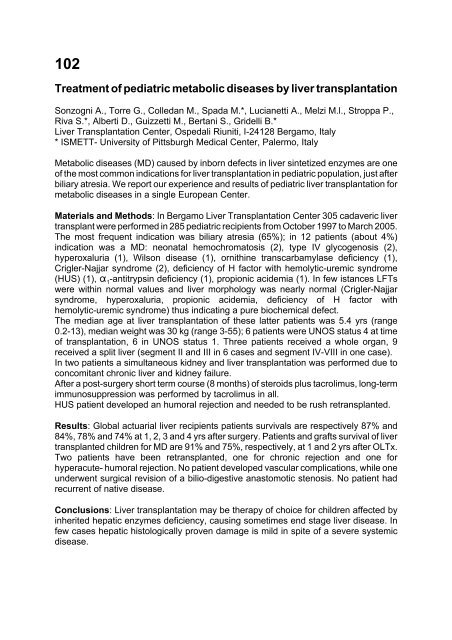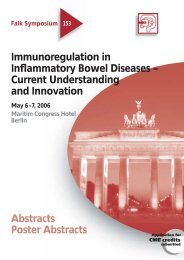Abstracts Poster Abstracts - Dr Falk
Abstracts Poster Abstracts - Dr Falk
Abstracts Poster Abstracts - Dr Falk
Create successful ePaper yourself
Turn your PDF publications into a flip-book with our unique Google optimized e-Paper software.
102Treatment of pediatric metabolic diseases by liver transplantationSonzogni A., Torre G., Colledan M., Spada M.*, Lucianetti A., Melzi M.l., Stroppa P.,Riva S.*, Alberti D., Guizzetti M., Bertani S., Gridelli B.*Liver Transplantation Center, Ospedali Riuniti, I-24128 Bergamo, Italy* ISMETT- University of Pittsburgh Medical Center, Palermo, ItalyMetabolic diseases (MD) caused by inborn defects in liver sintetized enzymes are oneof the most common indications for liver transplantation in pediatric population, just afterbiliary atresia. We report our experience and results of pediatric liver transplantation formetabolic diseases in a single European Center.Materials and Methods: In Bergamo Liver Transplantation Center 305 cadaveric livertransplant were performed in 285 pediatric recipients from October 1997 to March 2005.The most frequent indication was biliary atresia (65%); in 12 patients (about 4%)indication was a MD: neonatal hemochromatosis (2), type IV glycogenosis (2),hyperoxaluria (1), Wilson disease (1), ornithine transcarbamylase deficiency (1),Crigler-Najjar syndrome (2), deficiency of H factor with hemolytic-uremic syndrome(HUS) (1), " 1 -antitrypsin deficiency (1), propionic acidemia (1). In few istances LFTswere within normal values and liver morphology was nearly normal (Crigler-Najjarsyndrome, hyperoxaluria, propionic acidemia, deficiency of H factor withhemolytic-uremic syndrome) thus indicating a pure biochemical defect.The median age at liver transplantation of these latter patients was 5.4 yrs (range0.2-13), median weight was 30 kg (range 3-55); 6 patients were UNOS status 4 at timeof transplantation, 6 in UNOS status 1. Three patients received a whole organ, 9received a split liver (segment II and III in 6 cases and segment IV-VIII in one case).In two patients a simultaneous kidney and liver transplantation was performed due toconcomitant chronic liver and kidney failure.After a post-surgery short term course (8 months) of steroids plus tacrolimus, long-termimmunosuppression was performed by tacrolimus in all.HUS patient developed an humoral rejection and needed to be rush retransplanted.Results: Global actuarial liver recipients patients survivals are respectively 87% and84%, 78% and 74% at 1, 2, 3 and 4 yrs after surgery. Patients and grafts survival of livertransplanted children for MD are 91% and 75%, respectively, at 1 and 2 yrs after OLTx.Two patients have been retransplanted, one for chronic rejection and one forhyperacute- humoral rejection. No patient developed vascular complications, while oneunderwent surgical revision of a bilio-digestive anastomotic stenosis. No patient hadrecurrent of native disease.Conclusions: Liver transplantation may be therapy of choice for children affected byinherited hepatic enzymes deficiency, causing sometimes end stage liver disease. Infew cases hepatic histologically proven damage is mild in spite of a severe systemicdisease.



